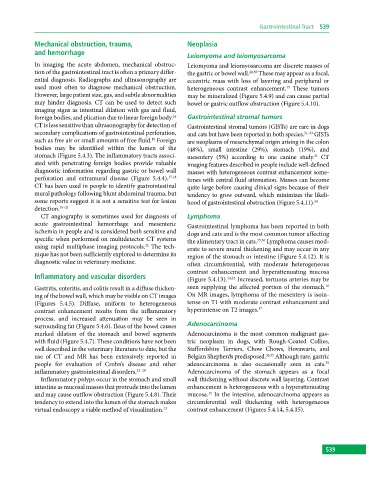Page 549 - Atlas of Small Animal CT and MRI
P. 549
Gastrointestinal Tract 539
Mechanical obstruction, trauma, Neoplasia
and hemorrhage Leiomyoma and leiomyosarcoma
In imaging the acute abdomen, mechanical obstruc Leiomyoma and leiomyosarcoma are discrete masses of
tion of the gastrointestinal tract is often a primary differ the gastric or bowel wall. 29,30 These may appear as a focal,
ential diagnosis. Radiographs and ultrasonography are eccentric mass with loss of layering and peripheral or
used most often to diagnose mechanical obstruction. heterogeneous contrast enhancement. These tumors
15
However, large patient size, gas, and subtle abnormalities may be mineralized (Figure 5.4.9) and can cause partial
may hinder diagnosis. CT can be used to detect such bowel or gastric outflow obstruction (Figure 5.4.10).
imaging signs as intestinal dilation with gas and fluid,
16
foreign bodies, and plication due to linear foreign body. Gastrointestinal stromal tumors
CT is less sensitive than ultrasonography for detection of Gastrointestinal stromal tumors (GISTs) are rare in dogs
secondary complications of gastrointestinal perforation, and cats but have been reported in both species. 31–33 GISTs
such as free air or small amounts of free fluid. Foreign are neoplasms of mesenchymal origin arising in the colon
16
bodies may be identified within the lumen of the (48%), small intestine (29%), stomach (19%), and
stomach (Figure 5.4.3). The inflammatory tracts associ mesentery (5%) according to one canine study. CT
31
ated with penetrating foreign bodies provide valuable imaging features described in people include well‐defined
diagnostic information regarding gastric or bowel wall masses with heterogeneous contrast enhancement some
perforation and extramural disease (Figure 5.4.4). 17,18 times with central fluid attenuation. Masses can become
CT has been used in people to identify gastrointestinal quite large before causing clinical signs because of their
mural pathology following blunt abdominal trauma, but tendency to grow outward, which minimizes the likeli
some reports suggest it is not a sensitive test for lesion hood of gastrointestinal obstruction (Figure 5.4.11). 34
detection. 19–21
CT angiography is sometimes used for diagnosis of Lymphoma
acute gastrointestinal hemorrhage and mesenteric Gastrointestinal lymphoma has been reported in both
ischemia in people and is considered both sensitive and dogs and cats and is the most common tumor affecting
specific when performed on multidetector CT systems the alimentary tract in cats. 35,36 Lymphoma causes mod
using rapid multiphase imaging protocols. The tech erate to severe mural thickening and may occur in any
22
nique has not been sufficiently explored to determine its region of the stomach or intestine (Figure 5.4.12). It is
diagnostic value in veterinary medicine. often circumferential, with moderate heterogeneous
contrast enhancement and hyperattenuating mucosa
Inflammatory and vascular disorders (Figure 5.4.13). 14,15 Increased, tortuous arteries may be
16
Gastritis, enteritis, and colitis result in a diffuse thicken seen supplying the affected portion of the stomach.
ing of the bowel wall, which may be visible on CT images On MR images, lymphoma of the mesentery is isoin
(Figures 5.4.5). Diffuse, uniform to heterogeneous tense on T1 with moderate contrast enhancement and
contrast enhancement results from the inflammatory hyperintense on T2 images. 37
process, and increased attenuation may be seen in
surrounding fat (Figure 5.4.6). Ileus of the bowel causes Adenocarcinoma
marked dilation of the stomach and bowel segments Adenocarcinoma is the most common malignant gas
with fluid (Figure 5.4.7). These conditions have not been tric neoplasm in dogs, with Rough‐Coated Collies,
well described in the veterinary literature to date, but the Staffordshire Terriers, Chow Chows, Hovawarts, and
use of CT and MR has been extensively reported in Belgian Shepherds predisposed. 33,35 Although rare, gastric
people for evaluation of Crohn’s disease and other adenocarcinoma is also occasionally seen in cats.
35
inflammatory gastrointestinal disorders. 23–28 Adenocarcinoma of the stomach appears as a focal
Inflammatory polyps occur in the stomach and small wall thickening without discrete wall layering. Contrast
intestine as mucosal masses that protrude into the lumen enhancement is heterogeneous with a hyperattenuating
and may cause outflow obstruction (Figure 5.4.8). Their mucosa. In the intestine, adenocarcinoma appears as
15
tendency to extend into the lumen of the stomach makes circumferential wall thickening with heterogeneous
virtual endoscopy a viable method of visualization. 13 contrast enhancement (Figures 5.4.14, 5.4.15).
539

